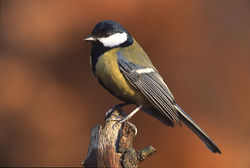| Tits and Chickadees | ||||||||||
|---|---|---|---|---|---|---|---|---|---|---|

Great Tit
|
||||||||||
| Scientific classification | ||||||||||
|
||||||||||
| See text. |
The tits, chickadees, and titmice, family Paridae, are a large family of small passerine birds which occur in the northern hemisphere and Africa. Most were formerly in the genus Parus; some recent authors have split this large group into several genera (as indicated below), which has been followed by North American ornithological authorities but not elsewhere.
On current evidence, only Pseudopodoces, Baeolophus, Melanochlora and Sylviparus are well supported as distinct genera from Parus (Harrap & Quinn, Tits, Nuthatches & Treecreepers, ISBN 0-7136-3964-4). The order in the list below follows Harrap & Quinn, with the incorporation of the recent split of Plain Titmouse into Oak and Juniper Titmice, and the addition of Hume's Ground Tit.
These birds are called "chickadees" (derived from their distinctive "chick-a dee dee dee" alarm call) or "titmice" in North America, and just "tits" in the rest of the English speaking world. The name titmouse is attested from the 14th century, composed of the Old English name for the bird, mase (Proto-Germanic *maison) and tit, denoting something small. The spelling was influenced by mouse in the 16th century. "Chickadee" is onomatopoeic, i.e., sounds like the call of many North American species.
These are mainly small stocky woodland species with short stout bills. Some have crests. They are adaptable birds, with a mixed diet including seeds and insects. Many species will live around human habitation and come readily to bird feeders for nuts or seed, and learn to take other foods. In England, Great Tits and Blue Tits learned to break open the foil caps sealing bottles of milk that had been delivered to homes to get at the cream floating on top.
These are hole-nesting birds laying speckled white eggs.
In the Sibley-Ahlquist taxonomy, the Paridae family is much enlarged to include related groups such as the Penduline tits and Long-tailed tits.
Species
- Marsh Tit, Parus palustris (Poecile palustris)
Black-bibbed Tit, Parus hypermelaena (Poecile hypermelaena)
Sombre Tit, Parus lugubris (Poecile lugubris)
Caspian Tit, Parus hyrcana (Poecile hyrcanus)
Willow Tit, Parus montanus (Poecile montana)
Songar Tit, Parus songarus (Poecile songara)
Carolina Chickadee, Parus carolinensis (Poecile carolinensis)
Black-capped Chickadee, Parus atricapilla (Poecile atricapillus)
Mountain Chickadee, Parus gambeli (Poecile gambeli)
Mexican Chickadee, Parus sclateri (Poecile sclateri)
White-browed Tit, Parus superciliosus (Poecile superciliosa)
Père David's Tit, Parus davidi (Poecile davidi)
Boreal Chickadee, Parus hudsonicus (Poecile hudsonica)
Siberian Tit or Gray-headed Chickadee, Parus cinctus (Poecile cincta)
Chestnut-backed Chickadee, Parus rufescens (Poecile rufescens)
Rufous-naped Tit or Black-breasted Tit, Parus rufonuchalis (Periparus rufonuchalis)
Rufous-vented Tit, Parus rubidiventris (Periparus rubidiventris)
Spot-winged Tit or Black-crested Tit, Parus melanolophus (Periparus melanolophus)
Coal Tit, Parus ater (Periparus ater)
Yellow-bellied Tit, Parus venustulus (Pardaliparus venustulus)
Elegant Tit, Parus elegans (Pardaliparus elegans)
Palawan Tit, Parus amabilis (Pardaliparus amabilis)
Crested Tit, Parus cristatus (Lophophanes cristatus)
Grey-crested Tit, Parus dichrous (Lophophanes dichrous)
White-shouldered Tit, Parus guineensis (Melaniparus guineensis)
White-winged Black Tit, Parus leucomelas (Melaniparus leucomelas)
Southern Black Tit, Parus niger (Melaniparus niger)
Carp's Tit, Parus carpi (Melaniparus carpi)
White-bellied Tit, Parus albiventris (Melaniparus albiventris)
White-backed Tit, Parus leuconotus (Melaniparus leuconotus)
Dusky Tit, Parus funereus (Melaniparus funereus)
Rufous-bellied Tit, Parus rufiventris (Melaniparus rufiventris)
Cinnamon-breasted Tit, Parus pallidiventris (Melaniparus pallidiventris)
Red-throated Tit, Parus fringillinus (Melaniparus fringillinus)
Stripe-breasted Tit, Parus fasciiventer (Melaniparus fasciiventer)
Acacia Tit or Somali Tit, Parus thruppi (Melaniparus thruppi)
Miombo Tit, Parus griseiventris (Melaniparus griseiventris)
Ashy Tit, Parus cinerascens (Melaniparus cinerascens)
Southern Grey Tit, Parus afer (Melaniparus afer)
Great Tit, Parus major
Japanese Tit, Parus minor
Turkestan Tit, Parus bokharensis
Green-backed Tit, Parus monticolus
White-winged Tit, Parus nuchalis
Black-lored Tit, Parus xanthogenys
Yellow-cheeked Tit, Parus spilonotus
Yellow Tit, Parus holsti (Macholophus holsti)
Blue Tit, Parus caeruleus (Cyanistes caeruleus)
Azure Tit, Parus cyanus (Cyanistes cyanus)
Yellow-breasted Tit, Parus flavipectus (Cyanistes flavipectus)
Varied Tit, Parus varius (Sittiparus varius)
White-fronted Tit, Parus semilarvatus (Sittiparus semilarvatus)
Bridled Titmouse, Baeolophus wollweberi
Oak Titmouse, Baeolophus inornatus
Juniper Titmouse, Baeolophus ridgwayi
Tufted Titmouse, Baeolophus bicolor
Black-crested Titmouse, Baeolophus atricristatus
Yellow-browed Tit, Sylviparus modestus
Sultan Tit, Melanochlora sultanea
Hume's Ground Tit, previously Hume's Ground Jay, Pseudopodoces humilis
(This species has only recently been removed from the Crow family Corvidae and placed into the Tit family.)
External links
- Chickadees Sing Complex Warnings
- Titmouse videos on the Internet Bird Collection




 216.73.216.91
216.73.216.91 User Stats:
User Stats:
 Today: 0
Today: 0 Yesterday: 0
Yesterday: 0 This Month: 0
This Month: 0 This Year: 0
This Year: 0 Total Users: 117
Total Users: 117 New Members:
New Members:
 18.235.xxx.xx
18.235.xxx.xx
 Server Time:
Server Time: